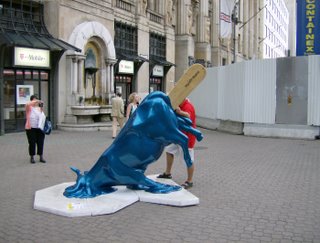Marcel Duchamp (1887-1968)
While the name Duchamp may not ring a bell, you have surely seen or heard about one or two of his works. For example, he is the artist that painted a jaunty mustache on a postcard reproduction of the Mona Lisa (1919). He also submitted, under the same R. Mutt, an inverted urinal to an art show (1917). Although the urinal was rejected from the show, it has become a legendary anti-sculpture.
I came to admire Duchamp’s self-described title as “respirateur” after reading Duchamp: A Biography by Calvine Tomkins. He was a man who lived his life by his own rules, unafraid to fly in the face of a conventional life and all its creature comforts. He breathed and he created things. In a world suffused with material objects, he transformed the mundane into art by making his “readymades.” He took a regular snow shovel, inscribed a cryptic title, signed it and it was art. Or was it? His art went beyond the visual and material elements associated with art and made his audience think and ask the question: what is art? (What would Duchamp have said about the CowParade?)
Duchamp inspired young artists to think freely, think boldly about both art and life. Some criticized Duchamp for all the bad art that sallied forth in the late twentieth century. And there has been some regrettable artwork. And yet I have to say that Duchamp has inspired me in a positive way. It is my job to be a “respirateur.” For too long I have been enslaved by doctrinal dictates and good-girl standards that compel me to observe and serve the world. Being a good-girl perfectionist, the observe-and-serve mandate dictates when it should merely guide.
First, one must breathe and then one can observe and just observe. Only then can I witness to what I see. Witness by my writing. By my art. And finally by my actions.
Duchamp taught me that it is okay to merely observe the world. In fact, it may be the finest act of humility there is. Of course, to accurately observe the world—to see truthfully what there is and what there should be—is enough for a lifetime. Practically, his life and art have also given me permission to write my novel by my own rules.



